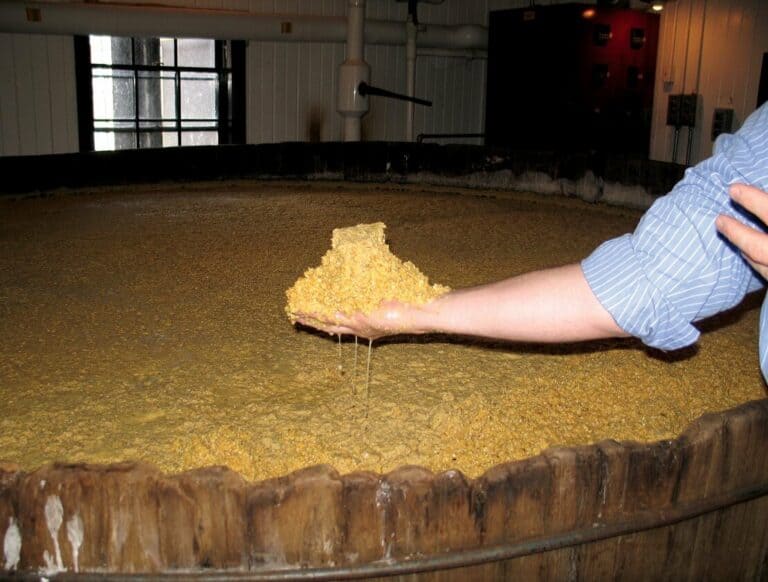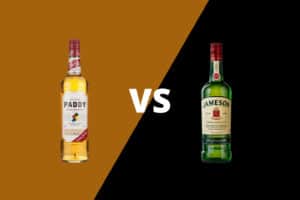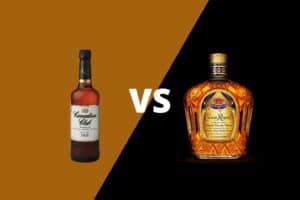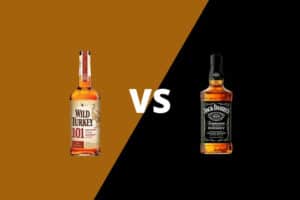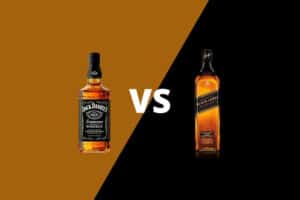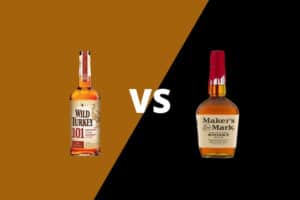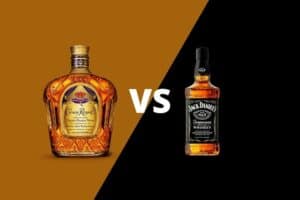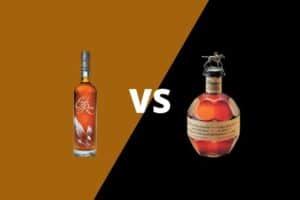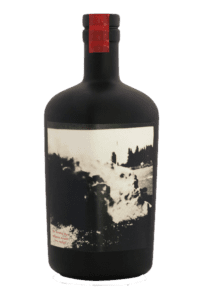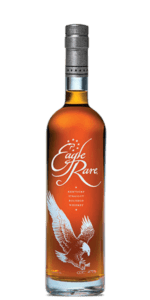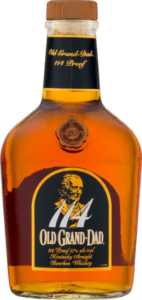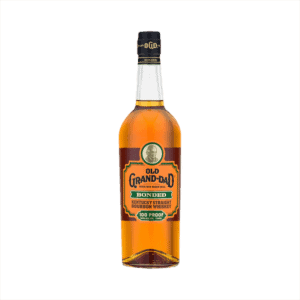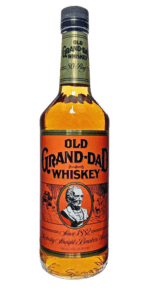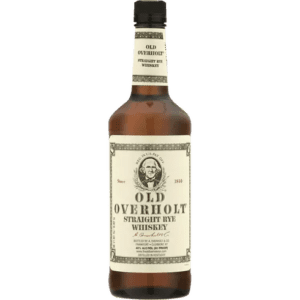Sour mash whiskey.
If you’re a whiskey fan, you’ve likely seen this term on a bottle of American whiskey — rye, bourbon or Tennessee.
But what is sour mashing? And what does it have to do with the fermentation process?
For a topic like sour mash, there are two distinct angles to approach the fermentation process — chemistry and history.
Table of Contents
History
The sour mash technique is a particular approach to fermentation that dates to early scientific breakthroughs in whiskey making during the 19th century. At the dawn of the Industrial Age, scientific-minded people like Dr. James C. Crow and contemporaries were discovering breakthroughs in the field of chemistry — unlocking the keys to mysteries that surrounded the fermentation, distillation and maturation processes.
Those who studied our Alcohol Distillation 101 course understand that distilled spirits begin as a fermented alcoholic solution. To make whiskey, the distiller must produce a type of beer. So, before we explore how the sour mash process influenced bourbon whiskey in the 19th century, it makes sense to explore a brief recap of brewing history.
Let’s jump back — way back — to the dawn of civilization in what is known as the Fertile Crescent as early as 9000 BC. Many archeologists, ancient historians and anthropologists posit that it was a reliable source of fermentable fruits and grains to produce alcohol — not the need for food — that encouraged our earliest ancestors to give up their nomadic hunter-gatherer lifestyle and sow grain in sedentary plots.
This fact may be the direct result of one fantastic discovery by our neolithic ancestors — the ability to unlock the starches available in grains by converting them to digestible sugars that yeast can use to produce alcohol. The discovery of fermentation was preserved in cave paintings by early Babylonian tablets and Egyptian beer recipes recorded in hieroglyphics.
Yeast are single-celled microorganisms essential to the breadmaking and alcohol-production processes. They consume sugars and excrete heat along with ethyl alcohol and CO2. The former is the type of alcohol digestible by humans, and the latter is the gas that enables bread to rise.
Today, yeast strains are carefully cultivated by scientists under laboratory conditions. But in the past, bakers and brewers would have had to keep strains alive by maintaining sourdough starters.
It took another scientific leap to advance from beer production to distilled whiskey.
Islamic scholars discovered the art of distillation during the pursuit of preserving fragrances. Muslim scholars were pursuing the perfect perfume. Religious edicts forbade the consumption of alcoholic beverages. The word ‘alcohol’ actually derives from the Arabic ‘al-kuhl.’
Visiting monks realized the potential for making potent libations at home. As the monks returned to Europe, they applied the art of distillation to the fermented beverages already established across the Christian world. In the British Isles, those fermented beverages included beers that revolved around the incredible fermentable qualities of malted barley.
While the art of distillation evolved and improved over the following millennium, the scientific understanding of what was taking place was lacking. For example, during the Medieval period, brewers and distillers often attributed magic or divine intervention to some biochemical processes.
Beer production during this period often took place in Christian monasteries and abbeys. In addition to being fully-functional communities — complete with grain silage and bakeries — they also contained a talent pool of educated scholars who could devote their talents to quality ferments and artisans who could craft custom equipment needed for production.
Fast-forward to the early 19th century. A scientist from Inverness, Scotland, began to apply his doctoral knowledge of chemistry to the field of whiskey making.
Dr. James Crow took his love of whiskey with him when he emigrated to the United States. In 1823, he moved to Kentucky and began working as a distiller. In his pursuit of the perfect dram, he implemented several scientific advancements that benefit the industry to this day.
He invented the saccharometer — a device used to measure the proportion of fermentable sugars available in a solution. He also introduced the practice of testing the acidity of the mash to produce an environment with ideal pH conditions for fermentations. In addition, he paved the way in using a hydrometer to check the alcohol content of the spirits collected from the still — and used the recently invented Coffey still to collect that distillate at a constant, controlled proof. He was also a pioneer in the use of charred oak barrels to systematically mature the whiskey before distribution. And he arguably crafted the first ‘brand name’ — by branding his Old Crow whiskey name onto the staves of barrels that were distributed to bars and retailers. These improvements not only helped the resulting “Old Crow” whiskey to be one of the nation’s first recognized brand names and the leading whiskey in terms of sales for over a century.
He combined his advancements in fermentation with a tradition common in scotch whisky making — the use of backset — to pave the way for a method called the sour mash technique. Other contemporaries, such as Edmund Haynes Taylor, also contributed to developing the sour mash technique.
Today, distilleries in Kentucky, Tennessee and across the bourbon-making world use the sour mash technique to produce popular brands from Jack Daniel’s to Buffalo Trace.
What is Sour Mash?
Mash is a term used to describe the mixture of grain and hot water cooked to convert starches to sugars before adding yeast for fermentation. And the term sour mash describes a specific type of mash.
To create ideal conditions for the yeast, sour mash uses a portion of the spent mash from a previous ferment to start the upcoming mash. The spent mash changes the alkalinity and pH balance of the resulting mash and provides additional nutrients for the yeast during fermentation.
Sour Mash vs Bourbon: Is There Actually a Difference?
Bourbon is not required to be made using the sour mash technique. And any type of whiskey — including American rye whiskey, Tennessee whiskey and other sub-categories — can utilize the technique when fermenting the beer used in distillation. Furthermore, the United States Tax and Trade Bureau — which regulates label terms and definitions — does not hold a strict standard for the phrase. This combination of factors has led to customer confusion and misconceptions.
How To Make Sour Mash
Backset vs. Terminal Beer vs. Spent Mash vs. Lactobacillus
The sour mashing process goes by many different names.
This is where we get into the weeds. There are a few ways to create the conditions for a sour mash process during the fermentation phase of whiskey production. Below, you’ll see a short glossary of terms that might help you keep your sanity should you compare techniques from throughout the whiskey-making world. These terms help describe how to make sour mash in several different ways — and give you the context to take your knowledge of the subject another layer deeper.
Terminal Beer or Wash
One way to create a sour mash ferment includes keeping a portion of terminal beer from a previous ferment and introducing that liquid during the grind-in of the upcoming mash.
Mash is the term used for the grain-and-liquid solution as it is being cooked, cooled and readied for the introduction of yeast. Brewers will know this process well — during the mash phase, the complex starch molecules produced by the grain are converted into digestible sugars in a process called saccharification.
Once the yeast is pitched, the liquid undergoes fermentation — a yeast party where the microorganisms consume the available sugars and excrete CO2 and ethyl alcohol. This process can take anywhere from three to seven or more days. Afterward, the distiller is left with ‘beer’ in the United States or ‘wash’ in Scotland.
The length of this fermentation and the temperatures held in the vessel will create different results. For example, a long, slow fermentation may allow the yeast to survive longer, producing esters from the stresses of an increasingly acidic and alcohol-rich environment.
Beer is called ‘terminal’ once the sugar level has dropped and the alcohol content has risen to acceptable levels. But by using terminal beer or wash in the sour mash process, some yeast may survive from batch to batch, resulting in ambient yeasts contributing to the lab-produced strains used by the distiller and adding complexity to the finished product.
Backset
Distillers in the British Isles use some different terms during the production of whiskey. Backset describes a portion of a previous ‘wash’ used during the grind-in of grain to produce the next batch of ‘wort.’
In Scotland, the use of backset is especially prominent at single malt distilleries, where wash is required to be made using a mash bill — or a mixture of grains — of 100 percent malted barley.
Unlike most American bourbon, Tennessee and rye whiskeys, nearly all single malt distilleries lauter their wort before introducing it to the still. Like beer brewing, the lauter system uses a drain beneath a false bottom in the washback — or fermenter — to separate the grain from the liquid. This filtered beer is then distilled two or more times in a traditional copper pot still to produce the wide variety of single malt scotch whiskies we all know and love.
When producing wash, producers rinse the malted barley several times to produce a cloudy liquid environment to pitch their yeast. As a result, most distilleries save a portion of a third rinse from the previous batch to start the ‘wort’ of the next batch of grain.
This difference in style is partly made possible because of the increased enzymatic properties of malted barley compared to any other grain — like corn, wheat and rye.
Spent Grain
Spent grain is a term used to describe the residual mash leftover in the still after a stripping distillation.
This method collects low wines from the still after the beer or wort has been pumped into the chamber and then distilled. When beer is distilled on the grain, the remaining denatured remnants are called spent grain. Some distillers may add portions of this to a subsequent mash, although it is unclear if the dead yeast — which acts as a nutrient to the next generation of yeast — is preserved after the beer has been boiled and the alcoholic vapor collected.
Introducing Lactobacillus
The ‘sour’ in ‘sour mash’ might describe some of the flavor compounds excreted by yeast and other microorganisms during extended fermentation.
Certain acidic compounds can occur during fermentation — either due to extended fermentation periods, the introduction of ambient yeast or other microorganisms or through an infection during the fermentation phase. In the production of sour mash, distillers may court some of these compounds — including lactic acids.
Some distillers add the bacterial microorganism Lactobacillus directly to the mash — see Chuck Cowdery’s post] for an in-depth look — while others court specific types of yeast they know will produce the compound under the proper conditions.
Lactobacillus is often the key to sour beers, and can be added directly, encouraged through particular brewers or distiller’s yeast, or introduced through wooden washbacks, mash tuns, fermenters or other vessels during the fermentation phase. But anyone who has ever attempted to brew will tell you that sanitation is incredibly important when making beer. In whiskey, however, sanitation becomes less critical — not only can the still clean up many of the esters and congeners, but the maturation process will turn others into desirable flavor components while in the barrel.
In addition to the lactic acid contributed by lactobacillus and stressed yeast, compounds that are commonly contributed by microorganisms during fermentation include acrolein, acetic acid, dimethyl trisulfide and disulfide, hydrogen sulfide, ethyl laurate, phenyl ethyl acetate and caprate, iso-amyl acetate, amy alcohol, proponal, hexanal, dicetyl, acetaldehyde and acetal.
Mash Bill
The mash bill describes the mixture of grains used during the fermentation phase of any given whiskey. For example, many whiskeys are blended, in which case the mash bill describes the sum of the grain percentages in any batch of whiskey.
While the sour mash technique is most often associated with Kentucky Bourbon and Tennessee whiskey, there are no standards of identity preventing makers of other types of whiskey — e.g., rye whiskey and American single malt and even products produced outside of the U.S.
Examples…
Jack Daniel’s Tennessee Whiskey is perhaps the most prominent product that proudly proclaims ‘sour mash’ on the label. In fact, many whiskey drinkers — present company included — first read this term on the label of this ubiquitous brand.
Many brands attempt to lure customers to their brand by utilizing this term. See our Evan Williams vs Jack Daniel’s piece.
Pennsylvania distillery New Liberty has developed a specialty product utilizing heritage Bloody Butcher corn that utilizes actual heritage sourdough starter. This is an attempt to replicate historical flavors whiskey drinkers might’ve enjoyed in the past.
Michter’s Original Sour Mash Whiskey is another example of a brand leaning into this concept to produce beer.
E.H. Taylor Traditional Sour Mash Whiskey tells the story of this pioneer who was a contemporary of James Crow and utilizes a technique where they leave mash in the transfer line for days over the weekend to encourage funky flavors on the way between fermenter and still.

